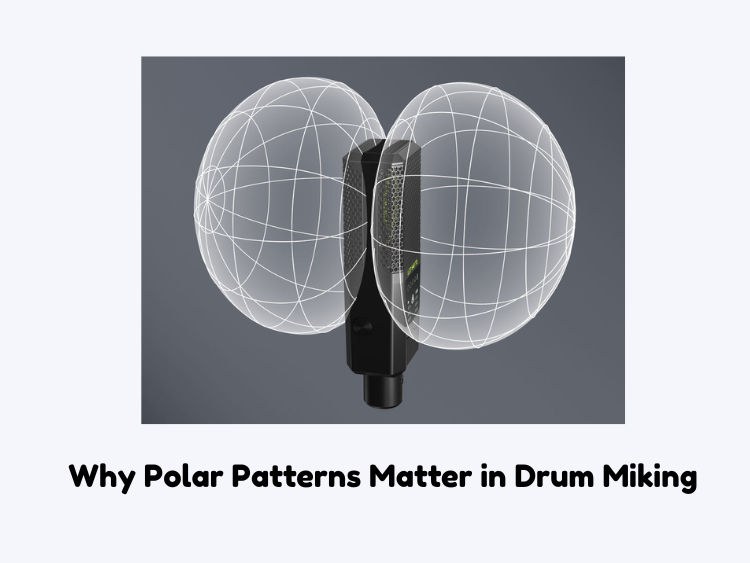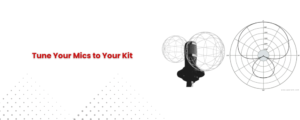Choosing a suitable microphone is only 50% of your strategy when it comes to drum miking. The polar pattern of the microphone, which is how it records sound from different directions, is a key contributor to achieving a clean, well-balanced drum sound. Knowing how the various polar patterns work will certainly help you achieve better isolation, reduced bleed, and improve the general tone of your recordings.
A set of drums is composed of many parts, and each has its own sound. A drum kit, unlike a guitar or piano, is an arrangement of separate drums and cymbals, all producing sound at the same time. This places even more importance on microphone placement and polar pattern selection. Select the wrong polar pattern and your mics could pick up too many unwanted vibrations, and you will have a messy and unfocused drum mix. But the right one can add clarity, depth, and punch, making sure that every component of the kit rings out clear as a bell.
Understanding Polar Patterns
The polar pattern of a microphone describes how it detects sound coming from various directions. There are different types of polar patterns, but the ones most used in drum recording are:
- Cardioid: Detects sound mostly from the front and rejects noise from the sides and rear.
- Omnidirectional: Takes in sound equally from every angle.
- Bidirectional (Figure-8): Captures sound from the front and back while rejecting the sides.
- Super-cardioid/Hyper-cardioid: Similar to cardioid but with a narrower pickup area and slightly more sensitivity to sounds coming from behind.
In regards to the mic placement, each of these patterns has its specific applications when miking drums, as they offer varying results depending on the type of sound (tight/punchy vs. wide and maintained) and how isolated you want the mics to be.
Polar Patterns in Drum Miking – Why They Matter
Bleed Control and Containment
Arguably, one of the greatest nightmares when recording drums is bleeding, which occurs when undesired overtones from other drums or cymbals enter a mic. For instance, if you mike a snare drum, some hi-hat will be captured as well. How much bleed, of course, depends on the mic’s polar pattern.
A cardioid microphone, like the 5Core Drum Mic Kit, is ideal for snare drums and toms as it captures sound primarily from the front while rejecting noise from behind. This design helps minimize hi-hat bleed, resulting in a cleaner mix. For even better isolation, super cardioid or hyper-cardioid microphones, such as the Shure Beta 57A or Sennheiser e604, offer a narrower pickup pattern, further reducing unwanted noise.
When it comes to kicking drums, a cardioid or super-cardioid mic like the 5Core Dynamic Kick Drum Mic, AKG D112, or Shure Beta 52A is a great choice. These mics effectively capture the punch and depth of the drum while reducing bleed from floor toms and cymbals. Dynamic microphones, like the 5Core DM50, are particularly well-suited for kick drums, ensuring clear, powerful low-end frequencies that cut through the mix.
Recorded Natural Live Zone Ambience
Close miking individual drums can go a long way, but a good drum mix loves a dose of natural room ambience. Room mics contribute depth and space so the drums sound more expansive and alive.
For room mics, you can use omnidirectional microphones because they capture sound in all directions, allowing the natural reverb of the room to come through. Or, if you need to record stereo techniques like Blumlein or Mid-Side (M/S), then figure-8 microphones, which are sensitive to sound from the front and reverse while rejecting the sides, may be handy. These techniques produce a wider stereo image, adding depth and realism to the drum mix.
Wilson Overhead Balance
Overhead mics are key to capturing the cymbals, as well as capturing the drum kit as a whole. The polar pattern you choose has a huge effect on the sound.
A pair of cardioid condensers, such as the 5Core overhead mics, help to focus the sound while minimizing room reflections, even in your controlled studio setting. But for an open, natural feel, omnidirectional overheads can be used so that the complete tone of the room is picked up.
Super-cardioid overheads are great in live applications where they need to reject stage noise. They also absorb sound hitting them from the sides more effectively, so the cymbals remain clear and defined.
Managing Phase Issues
When miking a drum kit with multiple microphones, you’re likely to face some phase issues. This occurs when two mics pick up the same sound wave, but slightly out of time, which causes frequencies to cancel each other out. The polar pattern you choose helps minimize these issues.
For instance, if you have a top and bottom mic on a snare drum, the phase of the bottom mic needs to be flipped to avoid cancellation. If the bottom mic has a polar pattern that differs from the top one, additional phase alignment considerations come into play.
Conversely, if overhead mics are too far apart, phase differences will abound and the sound will dissolve into a hollow or wan thing. Find the right polar pattern and placement for your mics, and it will go a long way toward maintaining a full, punchy drum tone.
Drum Sound Conversion with Multi Mic Techniques
Various polar patterns help shape the drum sound with more creative mic techniques. For instance:
- Mid-Side (M/S) Recording: Uses one cardioid mic (for direct sound) and one figure-8 mic (for side sound), creating a customizable stereo image.
- Glyn Johns Tip: Employs a combination of cardioid and omnidirectional microphones in order to achieve a warm sounding, natural drum sound with few mics.
- X/Y Overheads: Two cardioid mics at a 90-degree angle produce a generally accurate stereo image with minimal phase problems.
Conclusion
This type of pickup pattern is particularly important in the miking of drums, where it can determine the level of isolation and bleed, room ambience, phase issues, and more. This gets you the mains right and helps achieve a better overall drum level. Cardioid mics shine on snare, toms, and kick drums due to their focus and isolation. In contrast, omnidirectional mics provide room ambience and a natural stereo image, with figure-8 and super-cardioid mics supplying unique advantages in certain recording setups.
Knowing how polar patterns affect sound capture allows you to make choices that enhance the clarity, depth, and punch of your drum recordings. Using a high-quality microphone from trusted brands like 5Core, Shure, Sennheiser, AKG, and Audix, and placing it correctly, ensures a polished, dynamic drum sound—just like in a professional studio. Whether you choose a 5Core Drum Mics, a Shure SM57, an AKG D112, or an Audix i5, the right combination of mic type and placement will elevate your drum recordings to a whole new level.




